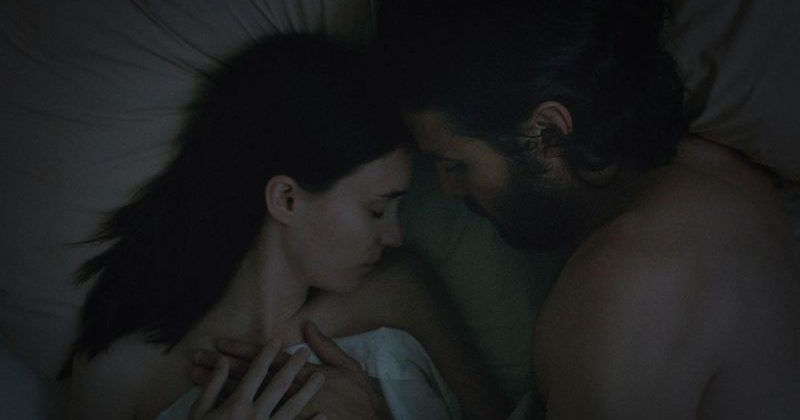
David Lowery has found his voice. After two fairly remarkable features (Ain’t Them Bodies Saints and Pete’s Dragon) that felt more imitative than original, here emerges something that answers only to itself. Its logline couldn’t be simpler – a man (Casey Affleck, credited as “C”) dies, and his ghost haunts the house he shared with his wife (Rooney Mara, “M”) until he can find peace. But it didn’t take the eventual leaps in time or the fact that C’s ghost is literally a man with a sheet over his head or Will Oldham’s late-film monologue to make it clear that Lowery was finally establishing his own rhythms.
Early on, a simple scene of M taking out the recycling begins with a whip-pan down from the sky, the camera then arching around the front of the house as Mara drags the bin down to the curb. It may sound small, but after years and years of slow cinema contentedly locking down its camera to depict mundanity, here is a film that’s alive and vibrant. Here, David Lowery has finally given us a vision of life purely as he sees it, not as he sees it through the lens of other movies he loves.
First, he sees love. C and M are having the sort of routine fights couples have. They’re getting ready to move and C isn’t quite ready to leave their house. But Mara and Affleck are so physically comfortable with one another. Lowery and cinematographer Andrew Droz Palermo, shooting in the 1.37:1 aspect ratio, capture the interaction of their fingers and toes, the way they lie together without the suggestion that we’re seeing anything unusually special. These are just two people who enjoy one another’s company, feed off one another’s energy, and depend on one another for everyday comfort. This is domestic bliss, disagreements and all.
So when C is torn from this environment, you immediately feel the rut M is in. The house feels so much emptier and devoid of life. The camera starts moving a little less. From this point on, the already-quiet film will go through a long period with no spoken dialogue. C soon reappears, clad in a white sheet with two black holes for eyes, but M can’t see him. He tries to comfort her, but can’t seem to affect the environment much. Since we can only project emotions onto him, he seems as distant to us as he is to her. She goes about her days. She repaints. She eats some pie. She exits and exits and exits the house. Soon, moving day comes, and she’s gone. And C is stuck at the house he’s chosen to haunt.
What follows is too imaginative and expansive to give away, but it’s the rare bit of genre deconstruction that has a foothold in emotional truth. The truth is that we’re all a little terrified of letting go, and what that will mean to a future that will eventually wipe us all away anyway. We will be forgotten, and our meager achievements erased. It is said that the key to happiness lies in accepting this. But does acceptance diminish our drive to create while we can? Is the simple act of creation sufficient unto itself, divested from grander attempts at the illusion of immortality? And who said immortality was so great anyway?
A Ghost Story is odd, tense, sometimes funny, and deeply moving. Amidst seventeen other films at Sundance, it was the only one to draw tears from these stone eyes. It’s curious and direct, heartfelt and unsentimental, and the most truly independent film in its intellect and artistic achievement I saw all weekend. I sat in awe of it, and remain so. David Lowery has found his voice, and it’s a rich, lovely one.



![Bergman Island (The Criterion Collection) [Blu-ray]](https://criterioncast.com/wp-content/uploads/2022/11/bergman-island-the-criterion-collection-blu-ray-400x496.jpg)
![This Is Not a Burial, It’s a Resurrection (The Criterion Collection) [Blu-ray]](https://criterioncast.com/wp-content/uploads/2022/11/this-is-not-a-burial-its-a-resurrection-the-criterion-collection-blu-ray-400x496.jpg)
![Lars von Trier's Europe Trilogy (The Criterion Collection) [The Element of Crime/Epidemic/Europa] [Blu-ray]](https://criterioncast.com/wp-content/uploads/2022/11/lars-von-triers-europe-trilogy-the-criterion-collection-the-element-of-400x496.jpg)
![Imitation of Life (The Criterion Collection) [Blu-ray]](https://criterioncast.com/wp-content/uploads/2022/11/imitation-of-life-the-criterion-collection-blu-ray-400x496.jpg)
![The Adventures of Baron Munchausen (The Criterion Collection) [4K UHD]](https://criterioncast.com/wp-content/uploads/2022/11/the-adventures-of-baron-munchausen-the-criterion-collection-4k-uhd-400x496.jpg)
![Cooley High [Criterion Collection] [Blu-ray] [1975]](https://criterioncast.com/wp-content/uploads/2022/11/cooley-high-criterion-collection-blu-ray-1975-400x496.jpg)